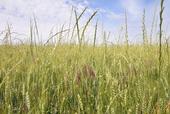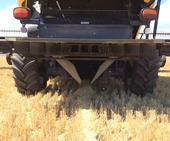- Author: Drew Lyon
- Posted by: Gale Perez

In my previous position as the Extension Dryland Cropping Systems Specialist with the University of Nebraska Panhandle Research and Extension Center in Scottsbluff, I focused my research efforts on intensifying and diversifying the winter wheat-fallow cropping system. The addition of summer crops into the rotation was a first step. Inserting summer crops such as proso millet, sunflower, or corn reduced the frequency of summer fallow from every other year to once every three years. Summer crops also helped in the management of winter annual grass weeds such as downy brome, jointed goatgrass, and feral rye. As I looked for ways to eliminate summer fallow from the rotation, my attention turned to forage...
- Author: Konrad Mathesius

Summary Review
Results from this year's Italian ryegrass (IR) herbicide trials helped quantify differences in herbicide resistance among IR populations within the southern Sacramento Valley. The trial took place in Bird's Landing, CA (near Rio Vista), and was replicated farther north in Esparto, CA.
- Trials from this year suggest that Osprey-resistant IR populations often associated with the area around Dixon, CA could extend at least as far south as Bird's Landing with only 26% control of IR by Osprey in the trial site.
- The Osprey-resistant population appears to also be moderately resistant to Simplicity, another herbicide in the same chemical...
- Author: Konrad Mathesius

Summary note: This is a belated research update from herbicide trials (targeting Italian ryegrass) carried out in the winter of 2021-2022 in wheat fields in the Esparto area. The southern Sacramento Valley saw a record number of consecutive days without rain in that year, which severely limited the efficacy of post-emergent systemic herbicides. Growers should prioritize scheduling post-emergent herbicide applications early in the weed's growth stages and when weeds are actively growing to avoid the severe reduction of herbicide efficacy that can occur as a result of unexpected droughty conditions. This is particularly important given that the weather systems in our...
- Author: Konrad Mathesius
- Contributor: Thomas Getts
- Contributor: José Luiz Carvalho de Souza Dias
- Editor: Brad Hanson
- View More...

Concerns about a growing resistance to herbicides
In Mediterranean or arid climates, particularly in areas with marginal soils, crop rotations are often limited to a narrow range of hay, pasture, a handful of winter legumes, or rainy-season grasses. Arid conditions and weathered soils drove Australia's rainfed grain growers to adopt no-till strategies earlier than their counterparts in California. While beneficial from a water use perspective, successful no-till systems depend on herbicides to control weeds that were traditionally kept in check with tillage.
Dependence on herbicides alone in these systems has resulted in weeds with resistance to multiple modes of action. In Australia, there is one...
- Author: Konrad Mathesius
- Contributor: Brad Hanson
- Contributor: Mark Lundy
Reposted from the UCANR Sacramento Valley Field Crops blog
Summary Note
Mechanical cultivation is a useful tool in controlling herbicide-resistant Italian ryegrass individuals in a rainfed wheat system but is only about half as effective as Axial in reducing overall pressure from Italian ryegrass (expressed as a percentage of total groundcover). Growers should consider multiple approaches (chemical and mechanical) and integrate IPM strategies to reduce the spread of resistance among...


